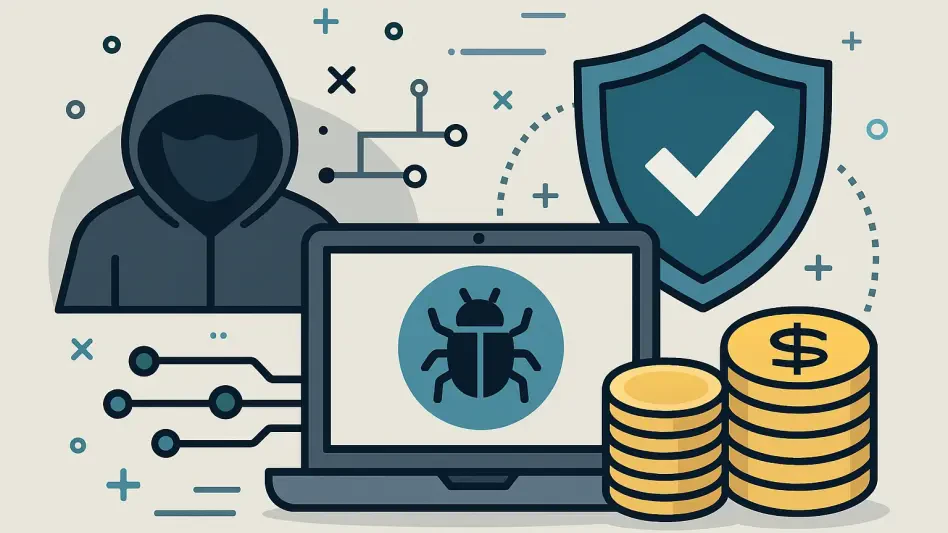In an era where cyber threats morph and multiply at an alarming rate, organizations across industries are scrambling to safeguard their digital landscapes, often finding traditional security measures falling short. Bug bounty programs have surged to the forefront as a revolutionary tactic, leveraging the skills of ethical hackers worldwide to uncover vulnerabilities before malicious actors can exploit them. By offering rewards for identifying flaws, these initiatives move beyond the constraints of conventional, fixed-cost penetration testing, embracing a dynamic, results-oriented model. This approach not only aligns with the rapid pace of digital transformation but also redefines how businesses prioritize and execute cybersecurity. As threats become more sophisticated, the ability to tap into a global talent pool for real-time insights offers a compelling edge, setting the stage for a deeper exploration of how such programs are reshaping security frameworks.
Economic Advantages in Modern Security
Cost-Effective Security Solutions
Bug bounty programs are redefining financial strategies in cybersecurity by prioritizing a pay-for-results framework over traditional upfront expenditures. Unlike conventional testing methods that demand significant initial investments regardless of outcomes, these programs ensure that organizations only compensate ethical hackers for verified vulnerabilities. This model proves especially beneficial in an environment where budgets are often stretched thin, allowing companies to maximize their return on investment. The savings generated can then be redirected toward critical areas such as remediation efforts or the adoption of advanced security tools. By focusing on tangible results, businesses gain a clearer picture of their spending efficiency, ensuring that every dollar contributes directly to enhancing their defensive posture against cyber threats.
Another key aspect of this economic advantage lies in the scalability that bug bounty programs offer to organizations of varying sizes. Small and medium-sized enterprises, often constrained by limited resources, find these initiatives particularly appealing as they provide access to high-level security expertise without the burden of fixed costs. Larger corporations, meanwhile, can tailor the scope of bounties to specific needs, avoiding overpayment for broad, unfocused assessments. This flexibility ensures that financial resources are aligned with actual security outcomes, fostering a more strategic allocation of funds. As a result, the cost-effectiveness of such programs not only addresses immediate budgetary concerns but also supports long-term planning for robust cybersecurity infrastructure, making them a practical choice in today’s threat landscape.
Budget Optimization Through Targeted Spending
The financial logic behind bug bounty programs extends into how they enable targeted spending on security priorities. By compensating only for actionable findings, organizations avoid the inefficiencies tied to blanket testing contracts that may yield little actionable insight. This precision in expenditure allows security teams to focus on high-impact vulnerabilities, ensuring that funds are channeled where they are most needed. Additionally, the competitive nature of bounties often drives ethical hackers to uncover critical flaws faster, further optimizing the cost-to-benefit ratio. This approach contrasts sharply with traditional models, where costs remain static regardless of the quality or relevance of results, offering a refreshing alternative for budget-conscious entities.
Moreover, the economic benefits are amplified by the reduced need for extensive in-house testing infrastructure. Maintaining a dedicated team for periodic assessments can be prohibitively expensive, especially when threats evolve unpredictably. Bug bounty programs alleviate this burden by outsourcing the discovery process to a global network, cutting down on overheads like salaries and training. This shift not only trims operational costs but also frees up internal resources to focus on strategic initiatives rather than routine vulnerability scans. The financial agility provided by such programs empowers organizations to adapt swiftly to emerging risks without being weighed down by rigid, pre-committed expenses, reinforcing their appeal as a cornerstone of modern security budgeting.
Leveraging Global Expertise for Enhanced Protection
Diversity in Expertise
One of the most compelling strengths of bug bounty programs is their ability to connect organizations with a vast, diverse pool of security researchers from around the globe. This international community brings an array of perspectives and specialized skills that often surpass the capabilities of internal teams or localized testing partners. Ethical hackers, hailing from varied backgrounds, are equipped to identify intricate vulnerabilities that might otherwise remain undetected, addressing blind spots in conventional security setups. This diversity proves invaluable in an industry grappling with a persistent talent shortage, providing access to expertise without the need for expensive, long-term hires. By harnessing global talent, companies can bolster their defenses with fresh insights tailored to the complex, ever-shifting nature of cyber threats.
Beyond merely filling skill gaps, the global reach of bug bounty programs fosters a culture of innovation in vulnerability discovery. Researchers often employ unique methodologies and tools shaped by their distinct experiences, uncovering issues that standardized testing might overlook. This variety ensures a more comprehensive assessment of digital assets, as different hackers focus on different attack vectors, from software bugs to configuration errors. For organizations, this means a richer, more nuanced understanding of their security posture, enabling them to address a broader spectrum of risks. The collaborative nature of these programs also encourages knowledge exchange among participants, further elevating the quality of findings and strengthening overall cybersecurity resilience across industries.
Bridging the Talent Gap
The cybersecurity field faces a well-documented shortage of skilled professionals, making the global talent pool accessed through bug bounty programs a critical asset. Organizations often struggle to recruit and retain experts capable of keeping pace with sophisticated threats, a challenge compounded by the high costs of building in-house teams. These programs offer a practical solution by connecting companies with independent researchers who bring niche expertise to the table, effectively extending the capacity of existing staff. This external support allows businesses to maintain a high level of protection without the financial strain of expanding permanent headcount, addressing immediate needs while navigating the broader talent crisis.
Furthermore, bug bounty programs provide a platform for emerging talent to gain experience and recognition, indirectly contributing to the growth of the cybersecurity workforce. Many researchers use these opportunities to hone their skills, test innovative techniques, and build reputations within the community, creating a pipeline of future experts. For organizations, this dynamic means access to both seasoned professionals and rising stars, ensuring a blend of established knowledge and cutting-edge approaches. This dual benefit not only mitigates the impact of talent shortages but also fosters a sustainable ecosystem where skill development and security needs align. As a result, the programs serve as a bridge between current demands and long-term industry growth, reinforcing their strategic importance.
Adapting to Threats with Continuous Monitoring
Continuous Security Insights
Bug bounty programs stand out for their ability to deliver real-time security validation, a stark contrast to the periodic snapshots provided by traditional testing methods. As cyber threats evolve unpredictably, the ongoing nature of these initiatives ensures that organizations remain informed about new vulnerabilities as they arise. This continuous monitoring aligns closely with the dynamic threat landscape, enabling security teams to respond promptly to risks rather than waiting for scheduled assessments. Some programs even allow for targeted bounties on critical systems or newly deployed technologies, ensuring focused attention where it matters most. This adaptability strengthens overall resilience, keeping defenses robust against emerging challenges.
The real-time insights gained from bug bounty programs also empower organizations to refine their security strategies proactively. Unlike static reports that may become outdated quickly, the constant flow of feedback highlights trends in attack methods and system weaknesses, offering a clearer view of evolving risks. This information is crucial for prioritizing remediation efforts, ensuring that the most pressing issues are addressed first. Additionally, the ability to engage hackers continuously means that security postures are tested under varying conditions, reflecting real-world scenarios more accurately. Such a proactive stance not only mitigates potential breaches but also builds a foundation for long-term security planning, making these programs an essential tool in modern defense arsenals.
Dynamic Threat Response
The agility of bug bounty programs in responding to dynamic threats sets them apart as a vital component of cybersecurity frameworks. As malicious actors continually develop new tactics, the ability to crowdsource vulnerability discovery in real time provides a significant advantage. Ethical hackers, motivated by rewards, often uncover flaws faster than traditional testing cycles allow, enabling organizations to patch issues before they can be exploited. This rapid response capability is particularly critical during periods of heightened risk, such as after major software updates or during high-profile cyberattack waves, ensuring that defenses remain relevant and effective against the latest dangers.
Moreover, the structure of bug bounty programs supports a tailored approach to threat response, allowing organizations to adjust focus based on immediate priorities. Whether it’s a newly identified exploit or a critical asset under scrutiny, the flexibility to direct researcher efforts ensures that resources are not wasted on low-impact areas. This targeted strategy contrasts with the broad, often inefficient scope of conventional assessments, delivering more actionable outcomes. By integrating real-time findings with internal security processes, companies can create a feedback loop that continuously improves their protective measures. This iterative process not only addresses current threats but also prepares systems for future challenges, solidifying the role of bug bounty programs in adaptive cybersecurity.
Cultivating a Collaborative Security Ecosystem
Building Ethical Hacking Communities
Bug bounty programs play a pivotal role in nurturing a collaborative culture within the cybersecurity realm by formalizing ethical hacking practices. These initiatives create structured environments where researchers can report vulnerabilities responsibly, often under legal protections that safeguard their efforts. This framework fosters trust among hackers, organizations, and end-users, ensuring that discoveries benefit all parties without compromising safety. Beyond individual transactions, the programs encourage knowledge sharing, allowing participants to learn from each other’s techniques and insights. Such collaboration elevates the collective understanding of security challenges, contributing to a more robust digital ecosystem.
Additionally, the community aspect of bug bounty programs promotes a sense of shared purpose among ethical hackers, aligning their skills with broader industry goals. Platforms hosting these initiatives often facilitate forums or events where researchers can exchange ideas, test concepts, and refine their approaches in a supportive setting. This camaraderie not only enhances individual capabilities but also drives innovation in vulnerability discovery, benefiting organizations with cutting-edge solutions. For companies, engaging with these communities signals a commitment to transparency and ethical practices, further strengthening stakeholder trust. By fostering a positive environment for white-hat hacking, these programs help shape a culture where security is a collective responsibility, extending their impact beyond immediate technical gains.
Promoting Responsible Disclosure
A cornerstone of bug bounty programs is their emphasis on responsible disclosure, ensuring that vulnerabilities are handled in a way that minimizes risk to all involved. Researchers are incentivized to report findings directly to organizations rather than publicizing them prematurely, allowing time for patches to be developed and deployed. This process, often guided by clear policies within the programs, balances the need for transparency with the protection of users and vendors. The result is a safer disclosure ecosystem where ethical hackers are recognized for their contributions without endangering digital infrastructure, reinforcing the integrity of the cybersecurity field.
The focus on responsible disclosure also helps build stronger relationships between organizations and the hacker community, creating a virtuous cycle of trust and collaboration. Companies that participate in these programs often establish dedicated channels for communication, ensuring that researchers feel valued and supported throughout the process. This open dialogue reduces the likelihood of adversarial interactions and encourages more hackers to engage ethically. Furthermore, by standardizing disclosure practices, bug bounty programs set a precedent for how vulnerabilities should be managed industry-wide, influencing even those outside direct participation. This broader impact underscores their role in advancing a principled approach to security, where protecting the digital landscape takes precedence over individual gain.
Positioning for Competitive Security Leadership
Leadership Through Innovation
Adopting bug bounty programs signals a forward-thinking approach to cybersecurity, positioning organizations as leaders in proactive protection. By embracing these initiatives, companies demonstrate a commitment to staying ahead of threats, which in turn enhances consumer confidence and brand reputation. The integration of advanced technologies like artificial intelligence further amplifies this impact, streamlining processes such as vulnerability validation and researcher matching. This fusion of human expertise and cutting-edge tools transforms security from a reactive cost center into a strategic business enabler, offering a distinct competitive edge in an increasingly digital marketplace.
Moreover, the innovative nature of bug bounty programs allows organizations to differentiate themselves in crowded sectors where trust is paramount. Customers and partners are more likely to align with entities that prioritize robust security practices, viewing such efforts as a mark of reliability. The visibility of participating in these programs also serves as a public testament to an organization’s dedication to safeguarding data, often influencing market perceptions positively. As digital transformation accelerates, those leveraging bug bounty initiatives are better equipped to navigate complex environments, turning potential liabilities into opportunities for growth. This strategic positioning not only mitigates risks but also redefines security as a core component of business success.
Enhancing Consumer Trust
The adoption of bug bounty programs directly contributes to building consumer trust by showcasing an organization’s proactive stance on cybersecurity. In an age where data breaches can erode confidence overnight, visible efforts to engage ethical hackers for vulnerability discovery reassure stakeholders that protection is a top priority. This transparency in addressing potential weaknesses fosters a sense of security among users, who value knowing that their information is actively defended. For businesses, this trust translates into stronger customer loyalty and a more resilient market position, as clients gravitate toward entities perceived as responsible stewards of digital assets.
Additionally, the structured nature of bug bounty programs ensures that security efforts are not just reactive but part of a broader, ongoing commitment to safety. Public acknowledgment of these initiatives, whether through program announcements or reported successes, reinforces the message that organizations are invested in continuous improvement. This consistent messaging can mitigate the fallout from potential incidents, as stakeholders are more likely to forgive entities that demonstrate diligence. By aligning security practices with consumer expectations, companies not only protect their operations but also cultivate enduring relationships built on mutual confidence. This trust becomes a cornerstone of long-term success, highlighting the strategic value of such programs beyond mere technical benefits.
Reflecting on a Safer Digital Legacy
Looking back, bug bounty programs have carved a transformative path in cybersecurity, reshaping how vulnerabilities are identified and addressed. Their ability to blend economic efficiency with access to global talent has redefined resource allocation, ensuring that defenses keep pace with relentless threats. The continuous insights they provide stand as a bulwark against evolving risks, while the communities they foster elevate ethical hacking into a respected pillar of digital safety. Strategically, organizations that embrace these initiatives not only fortify their systems but also cement their reputations as innovators. Moving forward, the challenge lies in expanding access to such programs for smaller entities, integrating emerging technologies for even greater impact, and advocating for global standards in responsible disclosure. These steps promise to sustain the momentum, ensuring that the collaborative spirit of bug bounty programs continues to shape a more secure digital future for all.








